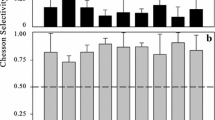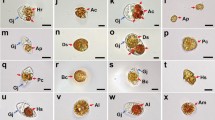Abstract
This study investigates the feeding behaviour of the precious red coral Corallium rubrum on bacterioplankton. The effects of flow rate, prey concentration, and seawater temperature were tested. The results obtained show that C. rubrum was able to prey on both pico- and nanoplankton cells. Flagellates constituted the major bacterioplankton food source in terms of carbon and nitrogen, representing from 43 to 70% of the C and N ingested. Flow speed (2, 6, and 11 cm s−1) had no effect on grazing rates, maybe due to the small size of the ingested particles. Conversely, feeding rates increased with prey concentration and seawater temperature. There was a doubling of the picoplankton ingestion rate for a sixfold increase in its concentration. The ingestion of autotrophic flagellates, however, increased at the same time as their concentration, indicating a preference for this type of food. Considering the range of concentrations typically found in the Ligurian Sea, the ingestion of pico- and nanoplankton brings 148 ng C polyp−1 day−1 and 28 ng N polyp−1 day−1. This type of food represents only ca. 4.5% of the total carbon gained by C. rubrum from the different sources, but might be the most important in terms of nitrogen, phosphorus, and other essential elements.






Similar content being viewed by others
References
Abbiati M, Buffoni G, Caforio G, Di Cola G, Santangelo G (1992) Harvesting, predation and competition effects of the red coral population. Neth J Sea Res 30:219–228
Abel EF (1970) Uber den tentakelapparat der Edelkoralle (Corallium rubrum L.) und seine function beim beutefangverhalten. Oecologia 4:133–142
Allemand D, Benazet-Tambutté S (1996) Dynamics of calcification in the Mediterranean red coral Corallium rubrum (Linnaeus) (Cnidaria, Octocorallia). J Exp Zool 276:270–278
Anthony KRN (1999) Coral suspension feeding on fine particulate organic matter. J Exp Mar Biol Ecol 232:85–106
Bramanti L, Magagnini G, De Maio L, Santangelo G (2005) Recruitment, early survival and growth of the Mediterranean red coral Corallium rubrum (L 1758), a 4-year study. J Exp Mar Biol Ecol 314:69–78
Bratbak G (1987) Carbon flow in an experimental microbial ecosystem. Mar Ecol Prog Ser 36:267–276
Bouillon J (1995) Classe des hydrozoaires. In: Grassé PP (ed) Traité de Zoologie: Cnidaires, Hydrozoaires, Scyphozoaires, Cubozoaires, Cténaires. Masson, Paris, pp 29–416
Caron DA, Dam HG, Kremer P, Lessard EJ, et al (1995) The contribution of microorganisms to particulate carbon and nitrogen in surface waters of the Sargasso Sea near Bermuda. Deep Sea Res I 42:943–972
Christaki U, Giannakourou A, Van Wambecke F, Gregori G (2001) Nanoflagellate predation on auto- and heterotrophic picoplankton in the oligotrophic Mediterranean Sea. J Plankton Res 23(11):1297–1310
Coma R, Gili JM, Zabala M, Riera T (1994) Feeding and prey capture cycles in the aposymbiotic gorgonian Paramuricea clavata. Mar Ecol Prog Ser 115:267–270
Coma R, Ribes M, Orejas C, Gili JM (1999) Prey capture by a benthic coral reef hydrozoan. Coral Reefs 18:141–145
Fabricius KE, Genin A, Benayahu Y (1995) Flow-dependent herbivory and growth in zooxanthellae-free soft corals. Limnol Oceanogr 31:878–887
Fabricius KE, Yahel G, Genin A (1998) In situ depletion of phytoplankton by an azooxanthellate soft coral. Limnol Oceanogr 43(2):354–356
Ferrier-Pagès C, Leclercq N, Jaubert J, Pelegri S (2000) Coupling between corals and microbes: enhancement of pico- and nanoplankton growth by coral exudates. Aquat Microb Ecol 21:203–209
Garrabou J, Harmelin JG (2002) A 20-year study of life history traits of a harvested long-lived temperate coral in NW Mediterranean: insights into conservation and management needs. J Anim Ecol 71:966–968
Giannini F, Gili JM, Santangelo G (2003) Relationships between the spatial distribution of red coral Corallium rubrum and coexisting suspension feeders at Medas Islands Marine Protected areas (Spain). Ital J Zool 70:233–239
Gili JM, Coma R (1998) Benthic suspension feeders: their paramount role in littoral marine food webs. Trends Ecol Evol 13:316–321
Grémare A, Amouroux JM, Charles F, Dinet A, Riaux-Gobin C, Baudart J, Medernach L, Bodiou JY, Vétion G, Colomines JC, Albert P (1997) Temporal changes in the biochemical composition and nutritional value of the particulate organic matter available to surface deposit-feeders: a two-year study. Mar Ecol Prog Ser 150:195–206
Gundersen K, Heldal M, Nordland S, Purdie DA, Knap AH (2002) Elemental C, N, and P cell content of individual bacteria collected at the Bermuda Atlantic Time series Study (BATS) site. Limnol Oceanogr 47:782–790
Houlbrèque F, Tambutté E, Richard C, Ferrier-Pagès C (2004) Importance of the micro-diet for scleractinian corals. Mar Ecol Prog Ser 282:151–160
Jochem F (1988) On the distribution and importance of pico-cyanobacteria in a boreal inshore area (Kiel Bight, Western Baltic). J Plankton Res 10:1009–1022
Lehman JT (1976) The filter-feeder as an optimal forager and the predicted shapes of feeding curves. Limnol Oceanogr 21:501–516
Levy O, Mizrahi L, Chadwick-Furman NE, Achituv Y (2001) Factors controlling the expansion behaviour of Favia favus (Cnidaria: Scleractinia). Effects of light, flow and planktonic prey. Biol Bull 200:118–126
Lewis JB (1982) Feeding behaviour and feeding ecology of the octocorallia (Coelenterata: Anthozoa). J Zool Lond 196:371–384
Marsh JA Jr (1970) Primary productivity of reef building calcareous red algae. Ecology 51:255–263
Pile AJ, Patterson MR, Witman JD (1996) In situ grazing on plankton < 10 μm by the boreal sponge Mycale lingua. Mar Ecol Prog Ser 88:9–17
Piniak GA (2002) Effects of symbiotic status, flow speed, and prey type on prey capture by the facultatively symbiotic temperate coral Oculina arbuscula. Mar Biol 141:449–455
Platt T, Rao DVS, Irwin B (1983) Photosynthesis of picoplankton in the oligotrophic ocean. Nature 301:702–704
Porter KG, Feig YS (1980) The use of DAPI for identifying and counting aquatic microflora. Limnol Oceanogr 25:943–948
Ribes M, Coma R, Gili JM (1998) Heterotrophic feeding by gorgonian corals with symbiotic zooxanthellae. Limnol Oceanogr 43:1170–1179
Ribes M, Coma R, Gili JM (1999a) Heterogenous feeding in benthic suspension feeders: the natural diet and grazing rate of the temperate gorgonian Paramuricea clavata (Cnidaria: Octocorallia) over a year cycle. Mar Ecol Prog Ser 183:125–137
Ribes M, Coma R, Gili JM (1999b) Seasonal variations of POC, DOC, and the contribution of microbial communities to the live POC in a shallow near-bottom ecosystem of the North-western Mediterranean Sea. J Plankton Res 21:1077–1100
Ribes M, Coma R, Rossi S (2003) Natural feeding of the temperate asymbiotic octocoral-gorgonian Leptogorgia sarmentosa (Cnidaria: Octocorallia). Mar Ecol Prog Ser 254:141–150
Rossi S, Ribes M, Coma R, Gili JM (2004) Temporal variability in zooplankton prey capture rate of the passive suspension feeder Leptogorgia sarmentosa (Cnidaria: Octocorallia), a case study. Mar Biol 144:89–99
Santangelo G, Abbiati M (2001) Red coral: conservation and management of an overexploited Mediterranean species. Aquat Conserv Mar Freshw Ecosyst 11:253–259
Santangelo G, Abbiati M, Giannini F, Cicogna F (1993) Red coral fishing trends in the western Mediterranean Sea. Sci Mar 57:139–143
Santangelo G, Carletti E, Maggi E, Bramanti L (2003) Reproduction and population sexual structure of the over-exploited Mediterranean red coral Corallium rubrum. Mar Ecol Prog Ser 248:99–108
Sebens KP, Vandersall KS, Savina LA, Graham KR (1996) Zooplankton capture by two scleractinian corals, Madracis mirabilis and Montastrea cavernosa, in a field enclosure. Mar Biol 127:303–317
Sebens KP, Witting J, Helmuth B (1997) Effects of water flow and branch spacing on particle capture by the reef coral Madracis mirabilis (Duchassing and Michelotti). J Exp Mar Biol Ecol 211:1–28
Sheldon RW, Rassoulzadegan F (1987) A method for measuring plankton production by particle counting. Mar Microbiol Food Webs 2(1):29–44
Shimeta J (1993) Diffusional encounter of submicrometer particles and small cells by suspension feeders. Limnol Oceanogr 38(2):456–465
Shimeta J, Jumars PA (1991) Physical mechanisms and rates of particle capture by suspension-feeders. Oceanogr Mar Biol Annu Rev 29:191–257
Shimeta J, Koehl MAR (1997) Mechanisms of particle selection by tentaculate suspension feeders during encounter, retention, and handling. J Exp Mar Biol Ecol 209:47–73
Shimeta J, Witucki PF, Hippe KR (2004) Influences of nutritional state and temperature on suspension-feeding rates and mechanics in the spionid polychaete Polydora cornuta. Mar Ecol Prog Ser 280:173–180
Smith PK, Krohn RI, Hermanson GT, Mallia AK, et al (1985) Measurement of protein using bicinchronic acid. Anal Biochem 150:76–85
Stockner JG, Antia NJ (1986) Algal picoplankton from marine and freshwater ecosystems: a multidisciplinary perspective. Can J Fish Aquat Sci 43:729–741
Trager GC, Hwang JS, Strickler JR (1990) Barnacle suspension-feeding in variable flow. Mar Biol 105:117–127
True MA (1970) Etude quantitative de quatre peuplements sciaphiles sur substrat rocheux dans la region marseillaise. Bull Inst Oceanogr Monaco 69:1–48
Tsounis G, Rossi S, Laudien J, Bramanti L, Fernàndez N, Gili J-M, Arntz W (2005) Diet and seasonal prey capture rates in the Mediterranean red coral (Corallium rubrum L.). Mar Biol (online first)
Tsounis G, Rossi S, Aranguren M, Gili J-M, Arntz W (2006) Effects of spatial variability and colony size on the reproductive output and gonadal development cycle of the Mediterranean red coral (Corallium rubrum L.). Mar Biol 148:513–527
Vedel A (1998) Phytoplankton depletion in the benthic boundary layer caused by suspension-feeding Nereis diversicolor (Polychaeta): grazing impact and effect of temperature. Mar Ecol Prog Ser 163:125–132
Verity PG, Williams SC, Hong Y (2000) Formation, degradation, and mass:volume ratios of detritus derived from decaying phytoplankton. Mar Ecol Prog Ser 207:53–68
Yukihira H, Lucas JS, Klumpp DW (2000) Comparative effects of temperature on suspension feeding and energy budgets of the pearl oysters Pinctada margaritifera and P. maxima. Mar Ecol Prog Ser 195:179–188
Zibrowius H, Montero M, Grashoff M (1984) La repartition de Corallium rubrum dans l’Atlantique. Thetis 11:163–170
Acknowledgments
We would like to thank Prof. D. Allemand (CSM) and Prof. L. Montaggioni (Univ. Aix-Marseille I) for their support in this work, which is part of the PhD thesis of M.P. funded by the French Ministry of Foreign Affairs and the Centre Scientifique de Monaco. We also thank two anonymous reviewers for their constructive comments.
Author information
Authors and Affiliations
Corresponding author
Additional information
Communicated by R. Cattaneo-Vietti, Genova.
Rights and permissions
About this article
Cite this article
Picciano, M., Ferrier-Pagès, C. Ingestion of pico- and nanoplankton by the Mediterranean red coral Corallium rubrum . Mar Biol 150, 773–782 (2007). https://doi.org/10.1007/s00227-006-0415-0
Received:
Accepted:
Published:
Issue Date:
DOI: https://doi.org/10.1007/s00227-006-0415-0




